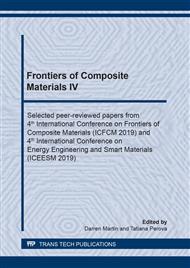[1]
M.M. Johari, J. Brooks, S. Kabir and P. Rivard: Influence of supplementary cementitious materials on engineering properties of high strength concrete. Construction and Building Materials 25 (2011), p.2639–2648.
DOI: 10.1016/j.conbuildmat.2010.12.013
Google Scholar
[2]
T. Akcaoglu, M. Tokyay and T. Celik: Assessing the ITZ microcracking via scanning electron microscope and its effect on the failure behavior of concrete. Cement and Concrete Research 35 (2015), p.358–363.
DOI: 10.1016/j.cemconres.2004.05.042
Google Scholar
[3]
P. Bílý, J. Fládr, R. Chylík, L. Vráblík and V. Hrbek: The effect of cement replacement and homogenization procedure on mechanical properties of high-performance concrete Magazine of Civil Engineering 8/84 (2018).
DOI: 10.4028/www.scientific.net/ssp.292.102
Google Scholar
[4]
V. Nežerka, J. Zeman and J. Němeček: Micromechanics-based simulations of compressive and tensile testing on lime-based mortars. Mechanics of Materials 105 (2017), p.49–60.
DOI: 10.1016/j.mechmat.2016.11.011
Google Scholar
[5]
V. Nežerka, V. Hrbek, Z. Prošek, M. Somr, P. Tesárek and J. Fládr: Micromechanical characterization and modeling of cement pastes containing waste marble powder. Journal of Cleaner Production 195 (2018), p.1081–1090.
DOI: 10.1016/j.jclepro.2018.05.284
Google Scholar
[6]
T. Mori and K. Tanaka: Average stress in matrix and average elastic energy of materials with mixfitting inclusions. Acta Metallurgica 21 (1973), p.571–574.
DOI: 10.1016/0001-6160(73)90064-3
Google Scholar
[7]
Y. Benveniste: A new approach to the application of Mori-Tanaka theory in composite materials. Mechanics of Materials 6 (1987), p.147–157.
DOI: 10.1016/0167-6636(87)90005-6
Google Scholar
[8]
V. Nežerka, P. Bílý, V. Hrbek and J. Fládr: Impact of silica fume, fly ash, and metakaolin on the thickness and strength of ITZ in concrete. Submitted to Cement and Concrete Composites (2019).
DOI: 10.1016/j.cemconcomp.2019.05.012
Google Scholar
[9]
B. Pichler, C. Hellmich and J. Eberhardsteiner: Spherical and acicular representation of hydrates in a micromechanical model for cement paste: prediction of early-age elasticity and strength. Acta Mechanica 203 (2009), p.137–162.
DOI: 10.1007/s00707-008-0007-9
Google Scholar
[10]
J. Stránský, J. Vorel, J. Zeman and M. Šejnoha: Mori-Tanaka based estimates of effective thermal conductivity of various engineering materials. Micromachines 2 (2011), p.129–149.
DOI: 10.3390/mi2020129
Google Scholar
[11]
J.D. Eshelby: The Determination of the Elastic Field of an Ellipsoidal Inclusion, and Related Problems. Proceedings of the Royal Society of London 241 (1957), p.376–396.
DOI: 10.1098/rspa.1957.0133
Google Scholar
[12]
G.W. Milton: The Theory of Composites. Cambridge Monographs on Applied and Computational Mathematics. Cambridge University Press (2002).
Google Scholar
[13]
W. Oliver and G.M. Pharr: An Improved Technique for Determining Hardness and Elastic Modulus Using Load and Displacement Sensing Indentation Measurements. Material Research 7 (1992), p.1564–1583.
DOI: 10.1557/jmr.1992.1564
Google Scholar
[14]
G. Constantinides et.al: Grid Indentation Analysis of Composite Microstructure and Mechanics: Principles and Validation. Material Science and Engineering A 430 (2006), p.189–202.
DOI: 10.1016/j.msea.2006.05.125
Google Scholar
[15]
F.-J. Ulm et.al: Statistical Indentation Techniques for Hydrated Nanocomposites: Concrete, Bone and Shale. Amercian Ceramic Society 90 (2007), p.2677–2692.
DOI: 10.1111/j.1551-2916.2007.02012.x
Google Scholar
[16]
L. Sorelli et.al: The nano-mechanical signature of Ultra High Performance Concrete by statistical nanoindentation techniques. Cement and Concrete Research 38 (2008), p.1447–1456.
DOI: 10.1016/j.cemconres.2008.09.002
Google Scholar
[17]
K. Wu, H. Shi, L. Xu, G. Ye and G.D. Schutter: Microstructural characterization of ITZ in blended cement concretes and its relation to transport properties. Cement and Concrete Research 79 (2016), p.243–256.
DOI: 10.1016/j.cemconres.2015.09.018
Google Scholar
[18]
Y. Gao, G.D. Schutter, G. Ye, H. Huang, Z. Tan and K. Wu: Characterization of ITZ in ternary blended cementitious composites: Experiment and simulation. Construction and Building Materials 41 (2013), p.742–750.
DOI: 10.1016/j.conbuildmat.2012.12.051
Google Scholar


